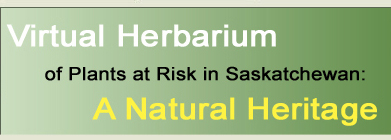
|

|

|

|

|

|

|
|
|
|
|
|
| Lithophragma glabrum Nutt. | Species Image Gallery (opens in a new window) |
||||||||||||||||||||||||||||||||||||||
| TAXONOMY | |||||||||||||||||||||||||||||||||||||||
| Family: | Saxifragaceae | ||||||||||||||||||||||||||||||||||||||
| Genus: | Lithophragma | ||||||||||||||||||||||||||||||||||||||
| Species Synonyms: | Lithophragma bulbiferum Rydb. Lithophragma glabrum var. bulbiferum (Rydb.) Jepson Lithophragma glabrum var. ramulosum (Suksdorf) Boivin |
||||||||||||||||||||||||||||||||||||||
| Common Names: | starflower bulbous wood-land-star rock-star |
||||||||||||||||||||||||||||||||||||||
| DISTRIBUTION | |||||||||||||||||||||||||||||||||||||||
| Canada: | southern British Columbia – southern Alberta – southwestern Saskatchewan | ||||||||||||||||||||||||||||||||||||||
| Saskatchewan: | southwestern Saskatchewan; Cypress Hills | ||||||||||||||||||||||||||||||||||||||
| Ecoregion: | Cypress Upland | ||||||||||||||||||||||||||||||||||||||
| HABITAT | |||||||||||||||||||||||||||||||||||||||
| Saskatchewan: | moist ravine slopes | ||||||||||||||||||||||||||||||||||||||
| Associated Species: | Perideridia gairdneri, Picea glauca, Potentilla gracilis | ||||||||||||||||||||||||||||||||||||||
| RARITY STATUS | |||||||||||||||||||||||||||||||||||||||
| Provincial
Status According to Harms (2003): |
Threatened |
||||||||||||||||||||||||||||||||||||||
| Nature Conservancy Status: | G4G5 S1 |
||||||||||||||||||||||||||||||||||||||
| Saskatchewan
Species at Risk Status: |
None |
||||||||||||||||||||||||||||||||||||||
| COSEWIC Status: | None |
||||||||||||||||||||||||||||||||||||||
| Lithophragma glabrum is threatened because of rarity in Saskatchewan. It is regionally restricted to one small region of the province. Possible threats have been identified for this species. | |||||||||||||||||||||||||||||||||||||||
| SPECIES DESCRIPTION | |||||||||||||||||||||||||||||||||||||||
| Height: | 10 – 20 cm | ||||||||||||||||||||||||||||||||||||||
| Roots: | rootstocks slender, bearing bulblets | ||||||||||||||||||||||||||||||||||||||
| Stems: | glandular- puberulent | ||||||||||||||||||||||||||||||||||||||
| Leaves: | basal and cauline; basal leaves ternately divided to the base, divisions 5 – 15 mm long and deeply 3-lobed, mostly glabrous; cauline leaves few, similar to basal leaves, usually with bulblets in the axils; stipules short, pinkish, fimbriate | ||||||||||||||||||||||||||||||||||||||
| Inflorescence: | raceme short, 3 – 6-flowered, flowers often replaced by bulblets | ||||||||||||||||||||||||||||||||||||||
| Flowers: | hypanthium puberulent, glandular; sepals 5, short; petals 5, 4 – 7 mm long, white or pinkish, 5-cleft; stamens 10, included; ovary more or less inferior, styles 3 | ||||||||||||||||||||||||||||||||||||||
| Fruits: | capsule 3-valved, many-seeded | ||||||||||||||||||||||||||||||||||||||
| |||||||||||||||||||||||||||||||||||||||